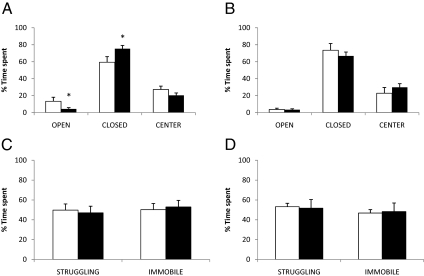Figure 2.
Mice were challenged with the elevated plus maze (EPM) and tail suspension test (TST) to test for anxiety-like and depressive-like symptoms, respectively. EPM: After 4 wk of treatment (A), corticosterone (black bars) and vehicle-treated (white bars) animals were each tested for a 10-min period, and the amount of time spent in each of the open arms (OPEN), closed arms (CLOSED), and the center (CENTER) is displayed as a percentage of the total time spent (10 min) on the apparatus. Same measurements were made at the conclusion of the 4-wk recovery period (B). TST: After 4 wk of treatment (C), corticosterone (black bars) and vehicle-treated (white bars) animals were tested for a 6-min period, and the amount of time spent struggling (STRUGGLING) or immobile (IMMOBILE) is displayed as a percentage of the total time spent (6 min) on the suspension apparatus. The same measurements were made at the conclusion of the 4-wk recovery period (D). Asterisks indicate differences that are statistically significant (P < 0.05).

